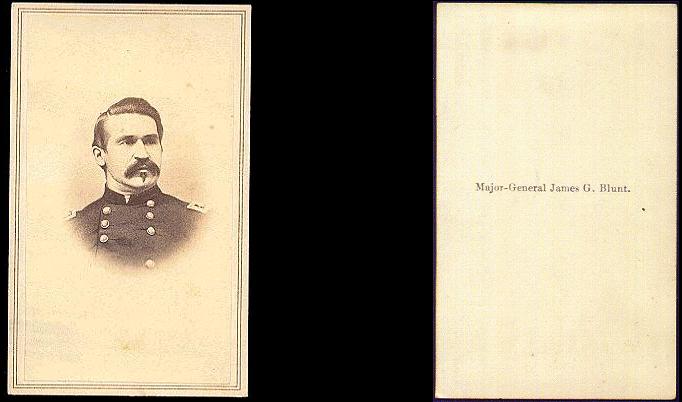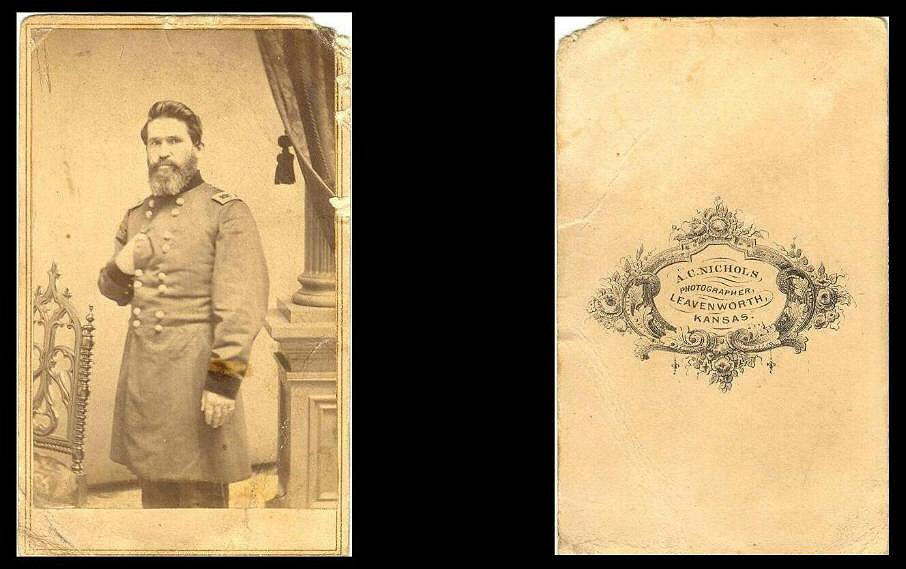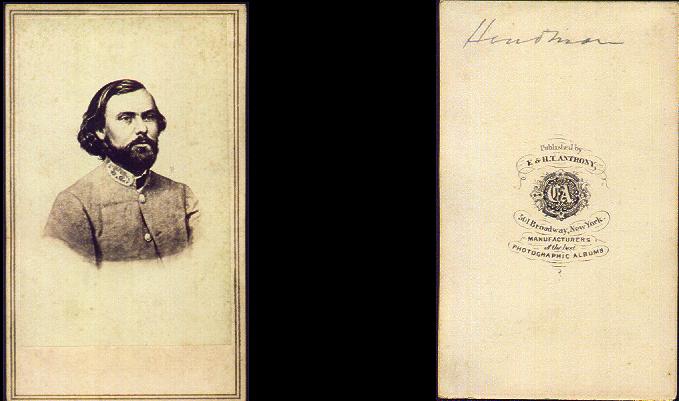These are scans of CDVs or Carte De Viste, actual photographs made during the Civil War. They are all from the personal collection of Steve Burgess and include the three main commanders at the Prairie Grove Campaign on December 7th, 1862 at which the 19th Iowa Infantry Co. C fought. A reunion photo of the surviving members of Co. C., of the 19th in 1883 is in the Prairie Grove Battlefield Park Museum in Prairie Grove, Arkansas. We are fortunate enough to have a copy of this 1883 photo
Maj. Gen. Thomas C. Hindman sought to destroy Brig. Gen. Francis Herron's and Brig. Gen. James Blunt's divisions before they joined forces. Hindman placed his large force between the two Union divisions, turning on Herron first and routing his cavalry. As Hindman pursued the cavalry, he met Herron's infantry which pushed him back.
The Rebels then established their line of battle on a wooded high ridge northeast of Prairie Grove Church. Herron brought his artillery across the Illinois River and initiated an artillery duel. The Union troops assaulted twice and were repulsed. The Confederates counterattacked, were halted by Union canister, and then moved forward again. Just when it looked as if the Rebel attack would roll up Herron's troops, Blunt's men assailed the Confederate left flank. As night came, neither side had won, but Hindman retreated to Van Buren. Hindman's retreat established Federal control of northwest Arkansas.
The original cards are 4 inches tall by 2 & 1/2 inches wide and the image process is called albumen and egg whites were used in the development.
The first one is Brigadier-General Francis J. Herron. (the 19th Iowa was in his Division. This photograph was taken by the most famous photographer of the Civil War era, Matthew Brady. His mark appears on the front and back of the photograph. His photo was taken after he was promoted to Major-General.

The next photo is General Herron's partner in defeating the Rebels at Prairie Grove, Brigadier-General James G. Blunt. He was Brigadier at Prairie Grove. Both he and Herron were promoted to Major-General after their victory at Prairie Grove, greatly incensing their immediate superior. This image is unattributed, but likely done by E. A. Anthony, who made copies of everybody else's work as well as some of his own.

A photo as General Blunt probably looked when he was at Prairie Grove as a Brigadier General

And finally, here is the Confederate Major-General Thomas C. Hindman who commanded the entire Southern Army at Prairie Grove. This image is an original by E. A. Anthony

Now, I know you are asking "How did a northern photographer get a picture of a southern general? And how did a New York photographer get a picture of a U. S. General from the Western Frontier, or Trans-Mississippi area. The story told by old timers in Civil War Image Collecting.
The public could not get enough details about the war. Newspapers were devoured at every issue and then passed on, and then again, and again. Photographers were quick to catch onto the interest and profit potential. If an image of General Lee or Stonewall Jackson was found on a prisoner, or abandoned on the battlefield, or purchased by an occupational soldier, with a Southern Photographer's back mark...northern photographers did not hesitate to copy it, put their own logo on it and sell it to the public. After all, those southern photographers were in the rebellious states and their inalienable rights as U. S. citizens were gone in the minds of the copiers. And the northern public wanted to see what their enemies looked like.
Some of the most valuable photographs of Robert E. Lee for example, are those taken by Matthew Brady, with studios in Washington and New York. A General Lee CDV in good condition with a Brady back mark is worth today from $1200 to $3000.